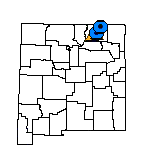Eriogonum aliquantum (Cimarron Wild-Buckwheat)
Family
POLYGONACEAE
Synonyms
NONE
Common Name
Cimarron Wild-Buckwheat
| USFWS | State of NM | USFS | BLM | Navajo Nation | State Rank | Global Rank | R-E-D Code | NMRPTC Status | Strategy Status |
|---|---|---|---|---|---|---|---|---|---|
| S2 | G2 | 2-1-3 | R | SS |
| Overall Conservation Status | Documented Threats | Actions Needed |
|---|---|---|
| UNDER CONSERVED | No Information |
document rarity and threat impacts |
Description
Annuals; stems erect-spreading, 1.0-3.5 dm tall; basal leaf blades broadly elliptic, 1.5-2.5 cm long, glabrous and green on both surfaces except for scattered villous hairs along the margins and midvein; stem leaves similar to basal leaves, but more reduced; inflorescence open, usually trichotomously branched at the first node then dichotomously branched above; flowers minute, 1-2 mm wide, yellow, glabrous within and without except for a sparsely hispid margin; achenes light brown, 1.7-2.3 mm long. Flowers July through August.
Similar Species
Distinguished from other New Mexico annual Eriogonum species by the character combination of yellow, nearly glabrous flowers and lack of dense tomentum on the lower leaf surface. It somewhat resembles E. divaricatum, but that species has a more spreading-prostrate growth form and pubescent flowers.
Distribution
New Mexico, Colfax County.
Habitat
Dry, eroded, shaley slopes with stands of low shrubs in, otherwise, short grass steppe; or low, clayey flats in alkali sacaton (Sporobolus airoides) grassland; 1,830-2,040 m (6,000-6,700 ft).
Remarks
Presently known only from the Cimarron, Vermejo, and Canadian river basins where the shortgrass prairie meets the foot of the Sangre de Cristo Mountains. Eriogonum aliquantum is most closely related to E. visheri of North and South Dakota.
Conservation Considerations
Most often found at the shallow erosion rills in the heads of small, dry drainages. These locations are frequently used to excavate stock water tanks. The resulting increased erosion appears to expand the habitat and population numbers of this species. It is not palatable to livestock.
Important Literature
Reveal, J.L. 1976. Eriogonum (Polygonaceae) of Arizona and New Mexico. Phytologia 34(5):409-484.
Information Compiled By
Robert Sivinski 1998
For distribution maps and more information, visit Natural Heritage New Mexico





